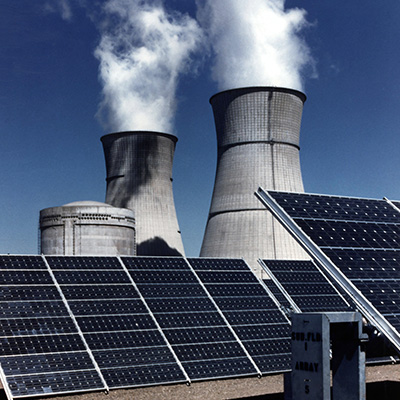Published On: Jan 06, 2016
The world is moving towards digital era where its sustainability depends upon the electrical and digital equipment like TVs, refrigerators, air conditioners,automated machines / production lines, etc.Life in one or the other wa yhas become easier and one can experience comfort due to use of these equipment. While these comes with an advantage, however at the same time they are also sensitive towards pure current or voltage wave forms and can malfunction due to its inadequacy to withstand supply variation from ideal standards.
With advances in power electronics and design engineering, electrical equipment are becoming more sophisticated and widespread. This has increased the proliferation of nonlinear loads and with that harmonics, a key determinant of power quality,has become a pronounced issue in many power systems.
In fact, according to some industry experts, nonlinear loads are approaching 75% to 90% of the loading on our nation’s electric utility distribution systems in certain areas.Some of these result in issues include: voltage supply distortion, power losses, electromagnetic interference, resonance, metering errors, instability, etc. Harmonics is becoming a major concern, specifically in industrial premises/unit sand hence there is an immediate need to mitigate them by appropriate methods.
This blog attempts to capture the ill-effects of harmonics on power systems resulting in equipment instability and non-performance by making it defective or unsuitable to use, and various mitigation methods to reduce its impact.
HARMONICS –A RISING PROTRUDING CRITICAL PQ ISSUE
The harmonics generated at utilization end gets superimposed with the power systems voltage and current wav eforms causing distortions. They can be produced in a plant and/or may enter a plant from the electric utility power system because of other offending sources on the line feeding the plant. The major concern for the electric utility is the quality of the voltage while the industrial user is responsible for the distortion of the current. In either case, harmonics cause the equipment to breakdown/malfunction or makes them prone to intermittent failure during the functioning thereby leading to inefficiency or high repair and maintenance cost. Harmonic related issues are primarily observed in key equipment like transformers, motors, conductors, generators, etc. making them over heated and eventually faulty for use. Some of the effects of harmonic issues include:
- Interference in the equipment operation: Harmonics interferes with the communication and auto control of equipment, there by making it defective during operation and breakdown over time.
- Increase of losses: Harmonic currents circulating in the power system increase losses and the heating of equipment.(Transformers, generators, etc. are more susceptible to incur these losses)
- Operational instability: Generators can have additional problems with excessive harmonic voltage distortion, causing multiple zero crossings of the current waveform. This can cause interference and operation instability.
- Unusual Breakdown: Due to the presence of harmonics, breaker and fuse operations may occur for no apparent reasons.
- Improper metering issue: Metering may not register properly due to the presence of harmonics in the system.
- Some other failures and mal-operations associated with harmonics on a power system are: Voltage notching, Computers or PLC lockups, overheating (motors, cables, transformers), Motor vibrations, Audible noise in the rotating parts of machines and transformers, Nuisance circuit breaker operations, Fuse tripping, Voltage and generator regulator malfunctioning, Timing or digital clock errors, electrical fires, etc.
- Further issues related to the presence of harmonics: include the failures or rupture of the capacitors. Semiconductor switching devices and inverters also tend to have harmonics distortion due to the abrupt voltage waveforms transition in them.
(Note: Our previous blog on ‘T&D Network Planning – Do Utilities consider Power Quality?‘ also covers a specific section on how harmonics affects electrical network assets.)
Thus, it can be clearly noted that harmonics are a major issue across most electrical equipment and it can’t be ignored any more. It is the need of the hour to use appropriate mitigation methods to reduce the level of harmonics and to protect the equipment from further troubles and its related repair or replacement costs.
METHODS TO MITIGATE HARMONICS
No harmonic mitigation solution or method is ideal for every application. Selecting any method involves a step-by-step approach like defining/quantifying the problem, major sources of harmonic generation and its load characteristics,understanding the acceptable level of harmonic distortion,followed by cost benefit (both Capital Cost and Operating Cost)for effective harmonic evaluation and mitigation. Harmonics mitigation can broadly be classified into Conventional and Modern solutions as follows:
Conventional Solutions
- Electrical system strengthening or wiring upgrade: Low capacity of the electrical system to with stand fluctuations in supply and improper/loose wiring leads to issues like overheating, short circuits,shocks, etc.thus resulting in the breakdown of devices or deterioration of wires. As a basic step, it is important to strengthen the electrical systems to be able to withstand higher loads.Also, regular maintenance/upgrading of wiring can reduce the strain on growing electronic appliances, lightning, etc. and also provide reliable power supply to modern gadgets in our life.
- Up sizing of equipment to cope up with effects of harmonics: The up/over sizing of equipment is basically is to reinforce the distribution system to withstand the harmonics. Reinforcing the distribution system means installing double-size neutral wires or installing separate neutral wires for each phase, and/or installing oversized or K- rated transformers, which allow for more heat dissipation. There are also harmonic-rated circuit breakers and panels, which are designed to prevent overheating due to harmonics. It is simple solution and requires relatively low capital costs.
- Use of Isolation transformer: Using large number of electronic motor drives in industrial facilities, can cause harmonic distortion, leading to malfunction of drives or damage to other connected equipment. To reduce the effects of motor drives on other loads in the electrical system, one common technique is to use isolation transformer, which provides reactive harmonic attenuation effects to reduce the actual distortion at the input terminals to the drives. Introducing an isolation transformer localizes the harmonic effect and prevents it from extending upstream and its damaging effect.The effectiveness of reactive harmonic attenuation varies, depending on other system characteristics.
- Phase shifting technique like Zig-Zag transformer etc: Harmonic voltages present in power systems can be reduced to some extent in zigzag windings due to opposite connection of winding coils present in zig-zag transformers.The windings also trap the harmonic currents and prevent them from traveling upstream, where they can produce undesirable effects.Here, the transformer creates a phase shift between the source and the load and is thus helpful in mitigating the harmonics issue.
- Right type of Filter i.e. Capacitor and Reactor Combination: This technique combines reactors and capacitors to form a circuit that offers a lower impedance path to harmonic frequencies than the power source. Due to this, the filter is tuned to provide a low-impedance path for the unwanted harmonic frequency. Here, the tuned filters are connected in parallel with the power source to divert harmonics into the filter and thus prevent some portion of the harmonic currents from flowing into the power source. This type of filter is suitable for use with single or multiple loads, including a combination of both linear and nonlinear loads.
Modern Solutions
- Passive Harmonic Filters: are constructed from a combination of power components that may include resistors, inductors and capacitors. In power systems, simple passive filters are usually constructed from capacitors and inductors, and are tuned for a specific harmonic frequency of interest. They provide an extremely cost effective solution to harmonic problems at all voltage levels. Passive Harmonic Filters solutions are applied extensively at distribution and transmission voltages across the world.
- Active Harmonic Filter: is the process by which harmonic current produced by the load is continuously monitored and an adaptive waveform is then generated which corresponds to the exact shape of the non-linear portion of the load current. The active filter capacity based upon harmonic current requirements can be selected, by determining the magnitude of harmonic current desired to be removed from the system. Unlike passive harmonic filters, these filters can provide harmonic mitigation under any load conditions up to their rated capacity.
- Hybrid Harmonic Filter: is the combination of passive and active harmonic filtering. It combines the two solutions in situations where the use of passive harmonic filters can be used reliably for static loads of an electrical installation and an active filter can be used to mitigate harmonics generated by other highly variable loads. This solution can be both, cost as well as application effective.
- Increasing effective source impedance: The harmonic current distortion can be predicted based upon the effective source impedance, which is essentially the voltage drop across the power source at the operating load current. It can increase the effective source impedance by adding either a line reactor or an isolation transformer ahead of the nonlinear load.
CONCLUSION
Harmonics will undoubtedly continue to become an increased cause of concern for end consumers and utilities alike as more equipment that produces them are added to electrical systems without harmonic monitoring and protection. It is, therefore, important to consider the impact of harmonics when contemplating additions or changes to a system. A system’s harmonic distortion levels depend on a number of factors such as impedance, mix of loads (linear and nonlinear), voltage distortion, operating conditions (percent load), converter type and others. Hence, it is crucial to undertake a detailed harmonic study to any power system known to have harmonics.A much better approach is to perform a harmonic analysis and apply proactive economical mitigation solutions besides energy efficiency benefits, which otherwise would incur, far greater expense and aggravation.
REFERENCES
- Harmonics – 2005 Platts, a Division of The McGraw Hill Companies, Inc.
- An Evaluation of Harmonic Mitigation Techniques – Worcester Polytechnic Institute
- A Review of Harmonic Mitigation Techniques – Gonzalo Sandoval & JohnHoudek, 2005
- Harmonics in Industrial Power Systems – Jun 1, 2009 Neal Ciurro
- Sources and mitigation of harmonics in industrial electrical power systems – A.Y. Abdelaziz, S. F. Mekhamer, Electrical Power and Machines Department, Faculty of Engineering, Ain Shams University, Cairo, Egypt
- Harmonics made simple – R. Fehr, Electrical Construction and Maintenance, Jan 1, 2004
- Analysis of Harmonics and Harmonic Mitigation Methods in Distribution Systems – M. Davudi, S. Torabzad, B. Ojaghi, Department of Electrical Engineering, Urmia Branch, Islamic Azad University, Urmia, Iran 2011
- Harmonics, Sources, Effects and Mitigation Techniques – Ali I. Maswood and M.H. Haque School of EEE, Nanyang Technological University Nanyang Ave. Singapore – Dec 2002
- Harmonic filtering – NHP Electrical Engineering Products Pty Ltd.
- DRIVE ISOLATION TRANSFORMERS— SOLUTIONS TO POWER QUALITY – Sqaure, D, August 1995, USA
- Mitigating harmonics in Industrial environments – John Houdek, Allied Industrial Marketing, June 1, 2007







